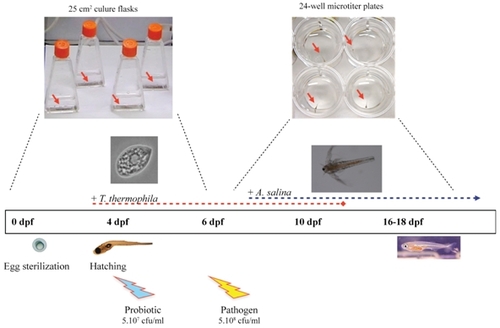Fig. S1
- ID
- ZDB-FIG-120830-11
- Publication
- Rendueles et al., 2012 - A new zebrafish model of Oro-intestinal pathogen colonization reveals a key role for adhesion in protection by probiotic bacteria
- Other Figures
- All Figure Page
- Back to All Figure Page
|
Protocol and timeline of axenic zebrafish infection and co-infection used in this study. After fertilization, eggs are sterilized and kept in sterile, autoclaved mineral water at 28°C in vented cap cell culture flasks until 6 dpf. Zebrafish larvae are then transferred one-by-one into 24-well microtiter plates containing 2 ml of water per well. Starting at 4 dpf, larvae are fed every 2 days with axenic T. thermophila till day 15. For longer experiments, in addition to Tetrahymena, larvae were also fed axenic A. salina from 10 dpf onwards. Pathogenic bacteria are added to the water at 6 dpf for 6 h and then larvae are transferred to fresh water. To test the protective effect of potentially probiotic strains, larvae were pre-colonized by commensal bacteria diluted in water at 4 dpf, after hatching. |

